| Pyotr Vereshchagin | |
|---|---|
| Пётр Петрович Верещагин | |
 Pyotr Vereshchagin Pyotr Vereshchagin(artist unknown) | |
| Born | (1834-01-14)January 14, 1834 Perm |
| Died | January 16, 1886(1886-01-16) (aged 52) Perm |
| Education | Member Academy of Arts (1873) |
| Alma mater | Imperial Academy of Arts (1865) |
| Known for | Painting |
Pyotr Petrovich Vereshchagin (Russian: Пётр Петрович Верещагин; 14 January 1834/36 in Perm – 16 January 1886 in Perm) was a Russian landscape and cityscape painter in the Academic style. He was the first to paint plein-air in the wilderness of the Urals.
Biography
His father, Pyotr Prokopovich (1795–1843) and grandfather, Prokopy Danilovich (1764-c.1811) were painters. His brothers, Vasily and Mitrofan (1842–1894) became painters as well. He was not related to the well-known military painter, Vasily Vasilyevich Vereshchagin.
His father was his first teacher. Later he studied with his maternal grandfather, a local icon painter named Ivan Babin. From 1858 to 1865, he was enrolled at the Imperial Academy of Arts, where his most influential instructor was Sokrat Vorobiev, a landscape painter who had spent many years in Italy.
His first exhibition came at the Academy in 1860 and he later received several silver medals. During these years, he also exhibited paintings of cityscapes, ranging from Moscow to Tallinn. He graduated as an "Artist, 3rd Degree" and worked as a teacher in Ludza; then part of the Vilna Governorate. In 1870, he gave up teaching and travelled for a year, painting. After that, he returned to Saint Petersburg. In 1873, he was named an "Academician".
He later exhibited internationally, as well as in Russia, participating in the Centennial Exposition in Philadelphia and the Exposition Universelle (1878) in Paris. In 1875 and 1876 he also worked for the Ural Railway Network, sketching scenes along the Chusovaya River, in preparation for extending the railway there. During the Russo-Turkish War, he painted with Russian troops in the Balkans and, on his return, created a panorama of the bombardment of the fortress at Ruse.
Selected paintings
-
 View of Baku from the sea (1872), National Art Museum of Azerbaijan
View of Baku from the sea (1872), National Art Museum of Azerbaijan
-
 Neva Embankment, St. Petersburg
Neva Embankment, St. Petersburg
-
 A view of Nevsky Prospekt in St. Petersburg
A view of Nevsky Prospekt in St. Petersburg
-
 View of St. Petersburg
View of St. Petersburg
-
 View of Melekkes (Dimitrovgrad today)
View of Melekkes (Dimitrovgrad today)
-
 Pskov (1876)
Pskov (1876)
-
 Sukhumi
Sukhumi
-
 Viceroy's Palace, Tiflis
Viceroy's Palace, Tiflis
-
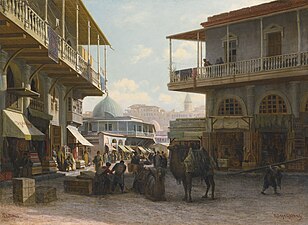 View of Tiflis
View of Tiflis
-
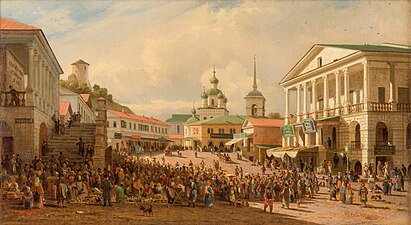 Lower Bazaar in Nizhny Novgorod (1860s), Gorky Museum
Lower Bazaar in Nizhny Novgorod (1860s), Gorky Museum
-
 The Market in Nizhny Novgorod
The Market in Nizhny Novgorod
-
 View of the Moscow Kremlin (1879), Yaroslavl Art Museum
View of the Moscow Kremlin (1879), Yaroslavl Art Museum
-
 View of the Kremlin from the Moskvoretsky Bridge
View of the Kremlin from the Moskvoretsky Bridge
-
Old Moscow (1878), Yekaterinburg Museum of Fine Arts
-
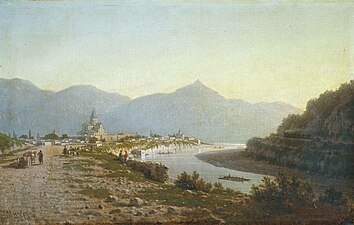 View of Mtskheta (1900)
View of Mtskheta (1900)
-
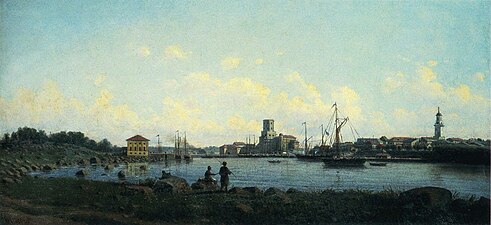 Harbour of Vyborg
Harbour of Vyborg
-
 Arkhipovka (1876), Perm Art Museum
Arkhipovka (1876), Perm Art Museum
-
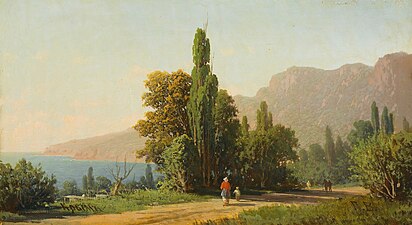 View of Ai-Petri (1883)
View of Ai-Petri (1883)
-
 Kamen' Molokov (1877)
Kamen' Molokov (1877)
-
 Pillar Stones
Pillar Stones
-
 Pisanny Stone on the Chusovaya River
Pisanny Stone on the Chusovaya River
-
 Interior of the Mezhyhirya Monastery
Interior of the Mezhyhirya Monastery
References
- In this name that follows Eastern Slavic naming customs, the patronymic is Petrovich and the family name is Vereshchagin.
- ^ Directory of the Imperial Academy of Arts 1915, p. 36.
- ^ Biography and appreciation @ Академик.
Literature
- С. Н. Кондаков (1915). Юбилейный справочник Императорской Академии художеств. 1764-1914 (in Russian). Vol. 2. p. 36.